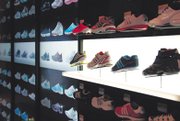Technology on Display
For its Spring 2011 designer campaign, Nordstrom worked with photographer Glen Luchford and artist Ruben Toledo to create a fashion spread that featured a bright ribbon of light running through the fashion images. On some pages, the names of the brand featured were written in illuminated script. On others, the light appeared to curl around the models before zipping off to the next page.
The retailer duplicated the effect in the windows of its flagship store in Seattle using the same technology found in an Xbox Kinect.
The technology allowed pedestrians to “paint” a similar ribbon of white light across Nordstrom’s window displays. Using Kinect’s infrared technology, customers painted messages and designs on the windows with just a wave of the hand.
Nordstrom’s interactive development, visual merchandising and operations teams worked together to create the display, which ran in early April. Microsoft Kinect is an Xbox accessory that allows players to use body motion instead of a traditional video game controller. Kinect uses an infrared projector and a pair of cameras to measure depth and sensors to track movement.
By giving pedestrians an opportunity to interact with the fashion on display, Nordstrom’s interactive windows also gave them another reason to stop and look.
Tech giant Intel is also getting in on the visual-display action with digital signage that features content tailored to the person—or people—watching the display. The signage uses anonymous video analytics (or AVA), a technology created by Canada-based Cogno Vision, which was acquired by Intel last year. AVA gathers data about the person standing in front of the sign, including measuring a person’s height, build and level of interest. The technology can guess if the person is a man or a woman and can gather data on several people at once. The signs are also semi-transparent, which allows them to direct the customer to specific merchandise on the sales floor. The displays also work as a map of the store, allowing customers to shop for other merchandise and browse other departments. And preferred customers can send search information to their phone using a Bluetooth connection.
The displays can gather additional data on how many people stopped by and how long they looked at the screen—and if the retailer is also using RFID tags, the displays can gather information on how often a customer who used the display also ended up purchasing an item.
German footwear maker Adidas employed a similar Intelbackedtechnology in its adiVerse, a virtual display wall that allows shoppers to browse through the complete Adidas catalog— up to 4,000 pieces each season.
Customers can select shoes off the touch-screen virtual wall, zoom in to see product details, spin them around for a 360-degree view, and look up product details and technical information. Shoppers can browse though video content embedded in the wall, check out the latest marketing campaign, and see what people are saying on Twitter and Facebook about the product. Shoppers can complete the purchase using a tablet computer at checkout and have them delivered to their home.
Adidas is pitching the concept as a way to offer customers the complete selection of the company’s products—even if the store only carries a small selection of styles.
According to company materials, the adiVerse Virtual Footwear Wall “ensures no one leaves a store disappointed.”
Built by British company Start Creative, the adiVersewall was on display at the National Retail Federation’s annual convention in New York earlier this year, as well as at the Digital Signage Expo inLas Vegas and CeBIT, the digital IT and telecommunications trade show in Germany. The virtual wall is expected to be in stores by 2012.
There's a video of Nordstrom customers quot;paintingquot; on the windows of the flagship store inSeattle on the Trade Talk blog at ApparelNews.net.






















